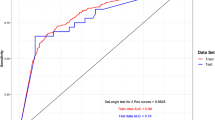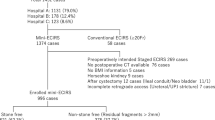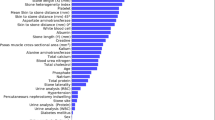Abstract
Introduction
To develop a predictive model incorporating stone volume along with other clinical and radiological factors to predict stone-free (SF) status at ureteroscopy (URS).
Material and methods
Retrospective analysis of patients undergoing URS for kidney stone disease at our institution from 2012 to 2021. SF status was defined as stone fragments < 2 mm at the end of the procedure confirmed endoscopically and no evidence of stone fragments > 2 mm at XR KUB or US KUB at 3 months follow up. We specifically included all non-SF patients to optimise our algorithm for identifying instances with residual stone burden. SF patients were also randomly sampled over the same time period to ensure a more balanced dataset for ML prediction. Stone volumes were measured using preprocedural CT and combined with 19 other clinical and radiological factors. A bagged trees machine learning model with cross-validation was used for this analysis.
Results
330 patients were included (SF: n = 276, not SF: n = 54, mean age 59.5 ± 16.1 years). A fivefold cross validated RUSboosted trees model has an accuracy of 74.5% and AUC of 0.82. The model sensitivity and specificity were 75% and 72.2% respectively. Variable importance analysis identified total stone volume (17.7% of total importance), operation time (14.3%), age (12.9%) and stone composition (10.9%) as important factors in predicting non-SF patients. Single and cumulative stone size which are commonly used in current practice to guide management, only represented 9.4% and 4.7% of total importance, respectively.
Conclusion
Machine learning can be used to predict patients that will be SF at the time of URS. Total stone volume appears to be more important than stone size in predicting SF status. Our findings could be used to optimise patient counselling and highlight an increasing role of stone volume to guide endourological practice and future guidelines.


Similar content being viewed by others
Data availability
Data is confidential and not avaiable for general requests.
References
Abufaraj M, Al Karmi J, Yang L (2022) Prevalence and trends of urolithiasis among adults. Curr Opin Urol 32(4):425–432. https://doi.org/10.1097/MOU.0000000000000994. (Epub 2022 Jun 9)
Geraghty RM, Proietti S, Traxer O, Archer M, Somani BK (2017) Worldwide impact of warmer seasons on the incidence of renal colic and kidney stone disease: evidence from a systematic review of literature. J Endourol 31(8):729–735. https://doi.org/10.1089/end.2017.0123. (Epub 2017 May 1PMID: 28338351)
Thongprayoon C, Krambeck AE, Rule AD (2020) Determining the true burden of kidney stone disease. Nat Rev Nephrol 16(12):736–746. https://doi.org/10.1038/s41581-020-0320-7. (Epub 2020 Aug 4)
Geraghty RM, Cook P, Walker V, Somani BK (2020) Evaluation of the economic burden of kidney stone disease in the UK: a retrospective cohort study with a mean follow-up of 19 years. BJU Int 125(4):586–594. https://doi.org/10.1111/bju.14991. (Epub 2020 Jan 24PMID: 31916369)
Skolarikos A, Gambari G, Neisius A, Petrik A, Somani B, Thomas K, et al. (2023) EAU guidelines on urolithiasis, Arnhem, The Netherlands: EAU Guidelines Office. Urolithiasis—GUIDELINES—Uroweb, March 2023 update (accessed April 2023)
Heidar NA, Labban M, Nguyen DD, El-Achkar A, Mansour M, Bhojani N, Nasr R (2022) Does volume matter? Incorporating estimated stone volume in a nomogram to predict ureteral stone passage. Can Urol Assoc J 16(3):E150–E154. https://doi.org/10.5489/cuaj.7364
Seiffert C, Khoshgoftaar T, Hulse J, Napolitano A (2008) RUSBoost: improving classification performance when training data is skewed. In: 19th International Conference on Pattern Recognition, pp. 1–4. https://ieeexplore.ieee.org/document/4761297
Rayhan F, Ahmed S, Mahbub A, Jani R, Shatabda S, Farid D, Rahman C (2011) MEBoost: mixing estimators with boosting for imbalanced data classification. J Mult-Valued Logic Soft Comput 17(2–3):255–287
Nembrini S, König IR, Wright MN (2018) The revival of the Gini importance? Bioinformatics 34(21):3711–3718. https://doi.org/10.1093/bioinformatics/bty373. (PMID: 29757357; PMCID: PMC6198850)
Song YY, Lu Y (2015) Decision tree methods: applications for classification and prediction. Shanghai Arch Psychiatry 27(2):130–135. https://doi.org/10.11919/j.issn.1002-0829.215044. (PMID: 26120265; PMCID: PMC4466856)
Fisher A, Rudin C, Dominici F (2019) All models are wrong, but many are useful: Learning a variable’s importance by studying an entire class of prediction models simultaneously. J Mach Learn Res 20:177
Tailly T, Nadeau BR, Violette PD et al (2020) Stone burden measurement by 3D reconstruction on noncontrast computed tomography is not a more accurate predictor of stone-free rate after percutaneous nephrolithotomy than 2D stone burden measurements. J Endourol 34:550–557. https://doi.org/10.1089/end.2019.0718
Hameed BMZ, Dhavileswarapu AVL, Raza SZ et al (2021) Artificial intelligence and its impact on urological diseases and management: a comprehensive review of the literature. J Clin Med 10(9):1864. https://doi.org/10.3390/jcm10091864. (PMID: 33925767; PMCID: PMC8123407)
Shah M, Naik N, Somani BK et al (2020) Artificial intelligence (AI) in urology-current use and future directions: an iTRUE study. Turk J Urol. 46(Supp 1):S27–S39. https://doi.org/10.5152/tud.2020.20117. (Epub 2020 May 27. PMID: 32479253; PMCID: PMC7731952)
Suarez-Ibarrola R, Hein S, Reis G, Gratzke C, Miernik A (2020) Current and future applications of machine and deep learning in urology: a review of the literature on urolithiasis, renal cell carcinoma, and bladder and prostate cancer. World J Urol 38(10):2329–2347. https://doi.org/10.1007/s00345-019-03000-5. (Epub 2019 Nov 5)
Tzelves L, Lazarou L, Feretzakis G, Kalles D, Mourmouris P, Loupelis E, Basourakos S, Berdempes M, Manolitsis I, Mitsogiannis I, Skolarikos A, Varkarakis I (2022) Using machine learning techniques to predict antimicrobial resistance in stone disease patients. World J Urol 40(7):1731–1736. https://doi.org/10.1007/s00345-022-04043-x. (Epub 2022 May 26PMID: 35616713)
Chen T, Zhang Y, Dou Q, Zheng X, Wang F, Zou J, Jia R (2022) Machine learning-assisted preoperative diagnosis of infection stones in urolithiasis patients. J Endourol 36(8):1091–1098. https://doi.org/10.1089/end.2021.0783. (Epub 2022 Apr 28)
Babajide R, Lembrikova K, Ziemba J, Ding J, Li Y, Fermin AS, Fan Y, Tasian GE (2022) Automated machine learning segmentation and measurement of urinary stones on CT scan. Urology 169:41–46. https://doi.org/10.1016/j.urology.2022.07.029. (Epub 2022 Jul 29)
Elton DC, Turkbey EB, Pickhardt PJ, Summers RM (2022) A deep learning system for automated kidney stone detection and volumetric segmentation on noncontrast CT scans. Med Phys 49(4):2545–2554. https://doi.org/10.1002/mp.15518. (Epub 2022 Feb 22)
Mannil M, von Spiczak J, Hermanns T, Poyet C, Alkadhi H, Fankhauser CD (2018) Three-dimensional texture analysis with machine learning provides incremental predictive information for successful shock wave lithotripsy in patients with kidney stones. J Urol 200(4):829–836. https://doi.org/10.1016/j.juro.2018.04.059. (Epub 2018 Apr 17)
Choo MS, Uhmn S, Kim JK, Han JH, Kim DH, Kim J, Lee SH (2018) A prediction model using machine learning algorithm for assessing stone-free status after single session shock wave lithotripsy to treat ureteral stones. J Urol 200(6):1371–1377. https://doi.org/10.1016/j.juro.2018.06.077. (Epub 2018 Jul 20)
Yang SW, Hyon YK, Na HS, Jin L, Lee JG, Park JM, Lee JY, Shin JH, Lim JS, Na YG, Jeon K, Ha T, Kim J, Song KH (2020) Machine learning prediction of stone-free success in patients with urinary stone after treatment of shock wave lithotripsy. BMC Urol 20(1):88. https://doi.org/10.1186/s12894-020-00662-x
Rice P, Pugh M, Geraghty R, Hameed BZ, Shah M, Somani BK (2021) Machine learning models for predicting stone-free status after shockwave lithotripsy: a systematic review and meta-analysis. Urology 156:16–22. https://doi.org/10.1016/j.urology.2021.04.006. (Epub 2021 Apr 21)
Alghafees MA, Abdul-Rab S, Aljurayyad AS, Alotaibi TS, Sabbah BN, Seyam RM, Aldosari LH, Alomar MA (2022) A retrospective cohort study on the use of machine learning to predict stone-free status following percutaneous nephrolithotomy: an experience from Saudi Arabia. Ann Med Surg (Lond). 84:104957. https://doi.org/10.1016/j.amsu.2022.104957. (eCollection 2022 Dec)
Zhu XH, Yang MY, Xia HZ, He W, Zhang ZY, Liu YQ, Xiao CL, Ma LL, Lu J (2019) Application of machine learning models in predicting early stone-free rate after flexible ureteroscopic lithotripsy for renal stones. Beijing Da Xue Xue Bao Yi Xue Ban 51(4):653–659. https://doi.org/10.19723/j.issn.1671-
Pietropaolo A, Geraghty RM, Veeratterapillay R et al (2021) A machine learning predictive model for post-ureteroscopy urosepsis needing intensive care unit admission: a case-control YAU endourology study from nine European centres. J Clin Med 10(17):3888. https://doi.org/10.3390/jcm10173888
Setia SA, Stoebner ZA, Floyd C, Lu D, Oguz I, Kavoussi NL (2023) Computer vision enabled segmentation of kidney stones during ureteroscopy and laser lithotripsy. J Endourol 37(4):495–501. https://doi.org/10.1089/end.2022.0511. (Epub 2023 Mar 10)
Abraham A, Kavoussi NL, Sui W, Bejan C, Capra JA, Hsi RJ et al (2022) Machine learning prediction of kidney stone composition using electronic health record-derived features. Endourol 36(2):243–250. https://doi.org/10.1089/end.2021.0211
Park JS, Kim DW, Lee D, Lee T, Koo KC, Han WK, Chung BH, Lee KS (2021) Development of prediction models of spontaneous ureteral stone passage through machine learning: comparison with conventional statistical analysis. PLoS ONE 16(12):e0260517. https://doi.org/10.1371/journal.pone.0260517
Yang B, Veneziano D, Somani BK (2020) Artificial intelligence in the diagnosis, treatment and prevention of urinary stones. Curr Op Urol 30(6):782–787
Umemoto T, Hasegawa M, Kawakami M, Nakano M, Nitta M, Kawamura Y, Shoji S, Miyajima A (2022) Impact of stone volume on treatment outcomes of percutaneous nephrolithotripsy. Asian J Endosc Surg 15(3):599–607. https://doi.org/10.1111/ases.13059. (Epub 2022 Mar 27PMID: 35343057)
Atalay HA, Canat L, Bayraktarlı R, Alkan I, Can O, Altunrende F (2018) Evaluation of stone volume distribution in renal collecting system as a predictor of stone-free rate after percutaneous nephrolithotomy: a retrospective single-center study. Urolithiasis 46(3):303–309. https://doi.org/10.1007/s00240-017-0995-9. (Epub 2017 Jun 23)
Funding
Funding from the Institute for Life Sciences (University of Southampton).
Author information
Authors and Affiliations
Contributions
G. Vigneswaran—Formal analysis and writing—Original draft preparation. R Teh—Data collection, analysis, review & editing. F Ripa—Data collection, editing. A Pietropao—Data collection. S Modi—Review & editing. J Chauhan—Review & editing. B K Somani—Conceptualization, methodology and review & editing.
Corresponding author
Ethics declarations
Conflict of interest
The authors declared no potential conflicts of interest with respect to the research, authorship, and/or publication of this article.
Ethical approval
The research protocols performed in this study complied with the ethical principles of the Declaration of Helsinki. This retrospective study was approved by HRA, IRAS 324872 (Ethical approval number).
Informed consent
All patients gave their consent for this study.
Additional information
Publisher's Note
Springer Nature remains neutral with regard to jurisdictional claims in published maps and institutional affiliations.
Supplementary Information
Below is the link to the electronic supplementary material.
Rights and permissions
Springer Nature or its licensor (e.g. a society or other partner) holds exclusive rights to this article under a publishing agreement with the author(s) or other rightsholder(s); author self-archiving of the accepted manuscript version of this article is solely governed by the terms of such publishing agreement and applicable law.
About this article
Cite this article
Vigneswaran, G., Teh, R., Ripa, F. et al. A machine learning approach using stone volume to predict stone-free status at ureteroscopy. World J Urol 42, 344 (2024). https://doi.org/10.1007/s00345-024-05054-6
Received:
Accepted:
Published:
DOI: https://doi.org/10.1007/s00345-024-05054-6




